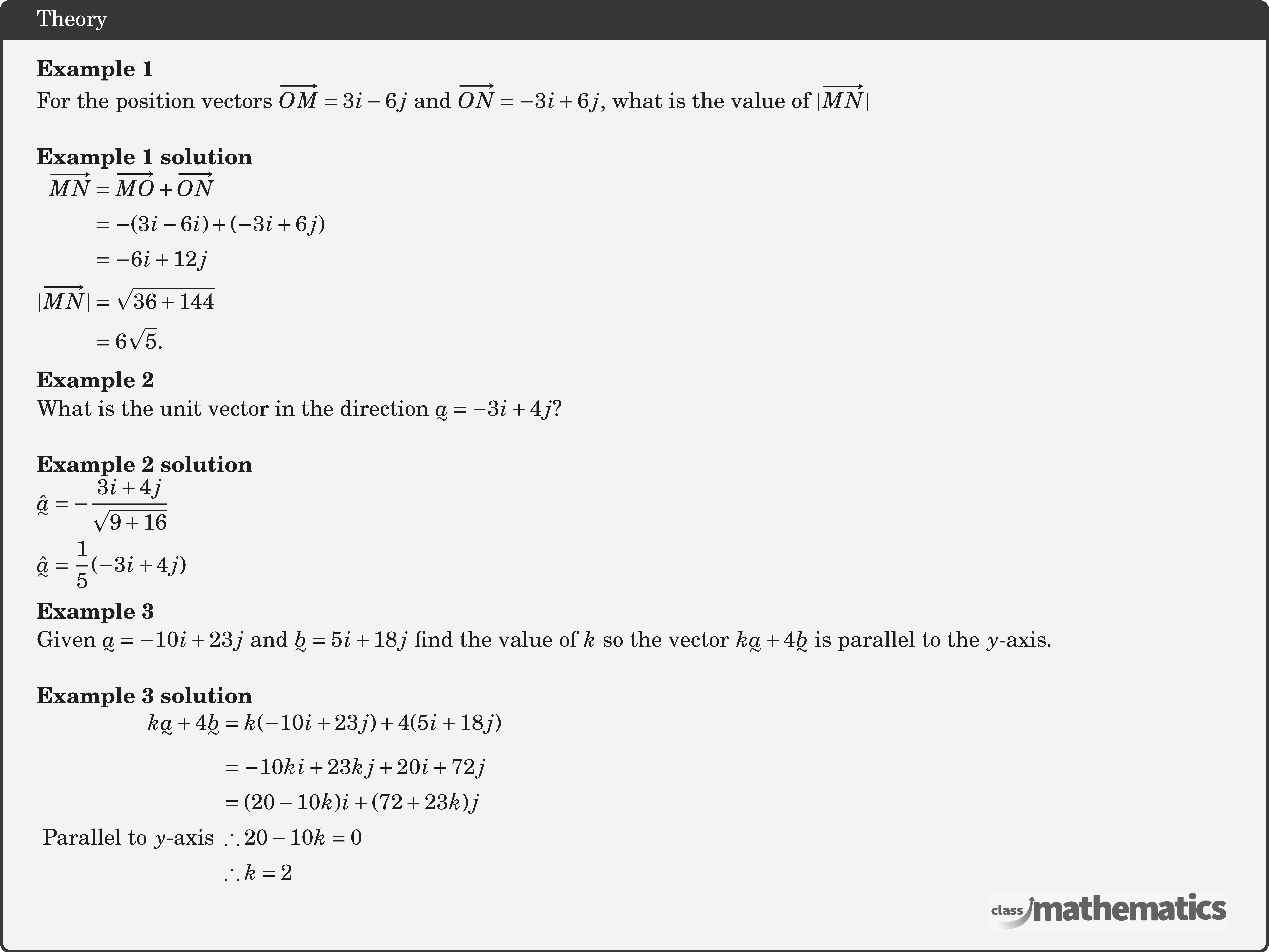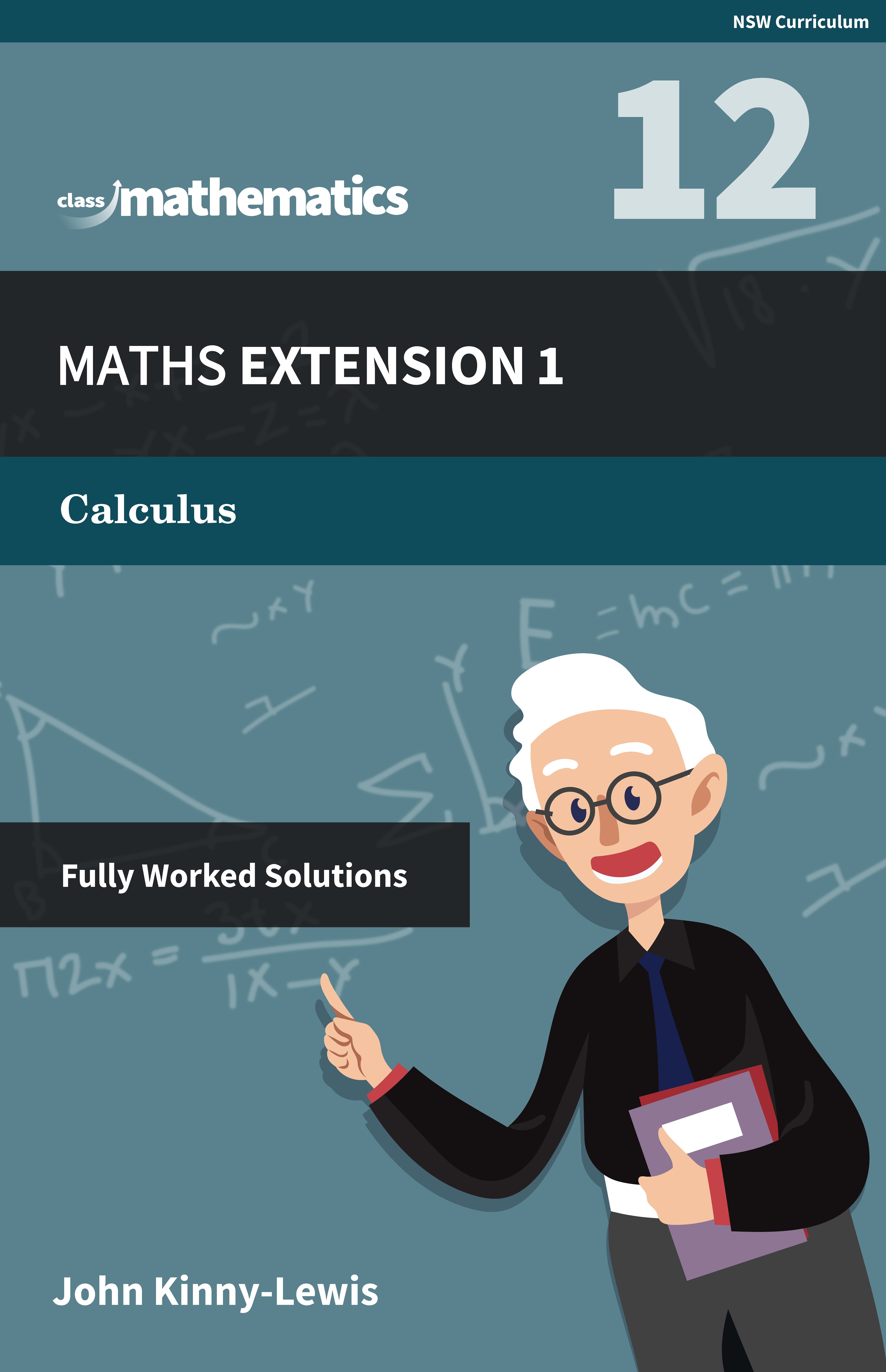Resources for Vectors in Component Form
-
Questions
11
With Worked SolutionClick Here -
Video Tutorials
1
Click Here -
HSC Questions
1
With Worked SolutionClick Here
Vectors in Component Form Theory
![The unit vector in the direction $\underset{\raise0.3em\hbox{$\smash{\scriptscriptstyle\thicksim}$}}{a} $ is denoted $\underset{\raise0.3em\hbox{$\smash{\scriptscriptstyle\thicksim}$}}{\hat{a}}$ where $\underset{\raise0.3em\hbox{$\smash{\scriptscriptstyle\thicksim}$}}{\hat{a}}$ \(=\dfrac{\underset{\raise0.3em\hbox{$\smash{\scriptscriptstyle\thicksim}$}}{a} }{|\underset{\raise0.3em\hbox{$\smash{\scriptscriptstyle\thicksim}$}}{a} |}\).\\ The component form of the vector $\underset{\raise0.3em\hbox{$\smash{\scriptscriptstyle\thicksim}$}}{a} $ is $\underset{\raise0.3em\hbox{$\smash{\scriptscriptstyle\thicksim}$}}{a} $\(=x i+y j\) which is equivalent to the column vector \(a=\left(\begin{array}{l}x \\ y\end{array}\right)\)\\ The magnitude of the vector $\underset{\raise0.3em\hbox{$\smash{\scriptscriptstyle\thicksim}$}}{a} $\(=x i+y i\) is \(|\underset{\raise0.3em\hbox{$\smash{\scriptscriptstyle\thicksim}$}}{a}|=\sqrt{x^2+y^2}\) Addition of vectors in component form if \(\underset{\raise0.3em\hbox{$\smash{\scriptscriptstyle\thicksim}$}}{a}=x_1 i+y_1 j\) and \(\underset{\raise0.3em\hbox{$\smash{\scriptscriptstyle\thicksim}$}}{b}=x_2 i+y_2 j\) then \(\underset{\raise0.3em\hbox{$\smash{\scriptscriptstyle\thicksim}$}}{a}+\underset{\raise0.3em\hbox{$\smash{\scriptscriptstyle\thicksim}$}}{b}=\left(x_1+x_2\right) u+\left(y_1+y_2\right) j\)\\ Subtraction of vectors in component form if \(\underset{\raise0.3em\hbox{$\smash{\scriptscriptstyle\thicksim}$}}{a}=x_1 i+y_1 j\) and \(\underset{\raise0.3em\hbox{$\smash{\scriptscriptstyle\thicksim}$}}{b}=x_2 i+y_2 j\) then \(\underset{\raise0.3em\hbox{$\smash{\scriptscriptstyle\thicksim}$}}{a}-\underset{\raise0.3em\hbox{$\smash{\scriptscriptstyle\thicksim}$}}{b}=\left(x_1-x_2\right) i+\left(y_1-y_2\right) j\)\\ Scalar multiplication of vectors in component form if \(a=x i+y j\) then \(k a=k x i+k y j\) \begin{multicols}{2} \textbf{Relative position vectors} \begin{center} \resizebox{0.3\textwidth}{!}{ \begin{tikzpicture} \draw[step=1cm, line width=0.2mm, black!40!white] (-5,-5) grid (5,5); \draw [draw=black] (-5,-5) rectangle (5,5); \draw[latex-latex,line width=0.5mm] (-5.5,0) -- (5.5,0) node[right]{\Large\(x\)}; \draw[latex-latex,line width=0.5mm] (0,-5.5) -- (0,5.5)node[above]{\Large\(y\)}; \foreach \x in {-5,-4,-3,-2,-1,1,2,3,4,5} \draw[thin] (\x,3pt )--(\x, -3pt ) node[anchor=north]{\Large\(\x\)}; \foreach \y in {-5,-4,-3,-2,-1,1,2,3,4,5} \draw[thin] (3pt, \y )--(-3pt, \y) node[anchor=east]{\Large\(\y\)}; \coordinate [label=below left:\Large$\mathbf{O}$ ] (O) at (0,0); \coordinate [ label=above:\Large$\mathbf{A}$ ] (A) at (2,3); \coordinate [ label=below:\Large$\mathbf{B}$ ] (B) at (3,-2); \draw[line width=2pt] (O)--(A)--(B)--cycle; \path[decoration={markings, mark=at position 1 with {\arrow{latex[scale=4.5]}}}, postaction=decorate,line width=3pt] (O)--(A); \path[decoration={markings, mark=at position 1 with {\arrow{latex[scale=4.5]}}}, postaction=decorate,line width=3pt] (O)--(B); \path[decoration={markings, mark=at position 1 with {\arrow{latex[scale=4.5]}}}, postaction=decorate,line width=3pt] (B)--(A); \end{tikzpicture} } %\includegraphics[width=0.3\textwidth]{13ef2623-6326-470b-85f2-84fd73b74083} \end{center} \columnbreak The position vector of A relative to \(B\) is \(\overrightarrow{A B}\)\\ $\begin{aligned} & \overrightarrow{A B}=\overrightarrow{A O}+\overrightarrow{O B} \\ & \overrightarrow{O A}=2 i+3j, \overrightarrow{O B}=3 i-2 j \\ & \therefore \overrightarrow{A B}=-\overrightarrow{O A}+\overrightarrow{O B} \\ &=-2i-3j+3i-2j \\ &=i-5j \end{aligned}$\\ \end{multicols} \textbf{Parallel vectors}\\ If \(\underset{\raise0.3em\hbox{$\smash{\scriptscriptstyle\thicksim}$}}{b}=k \underset{\raise0.3em\hbox{$\smash{\scriptscriptstyle\thicksim}$}}{a}\) then $\underset{\raise0.3em\hbox{$\smash{\scriptscriptstyle\thicksim}$}}{b}$ is parallel to \(\underset{\raise0.3em\hbox{$\smash{\scriptscriptstyle\thicksim}$}}{a}\).\\ Unit vectors in component form $\begin{aligned} \hat{a} & =\dfrac{\underset{\raise0.3em\hbox{$\smash{\scriptscriptstyle\thicksim}$}}{a}}{|\underset{\raise0.3em\hbox{$\smash{\scriptscriptstyle\thicksim}$}}{a}|} \\ \text { If } \underset{\raise0.3em\hbox{$\smash{\scriptscriptstyle\thicksim}$}}{a} & =x i+y j \\ \text { then } \hat{a} & =\dfrac{x i+y j}{\sqrt{x^2+y^2}} \\ \text { OR } \hat{a} & =\dfrac{1}{\sqrt{x^2+y^2}}(x i+y j) \end{aligned}$\\](/media/5lmfurif/3951.png)


